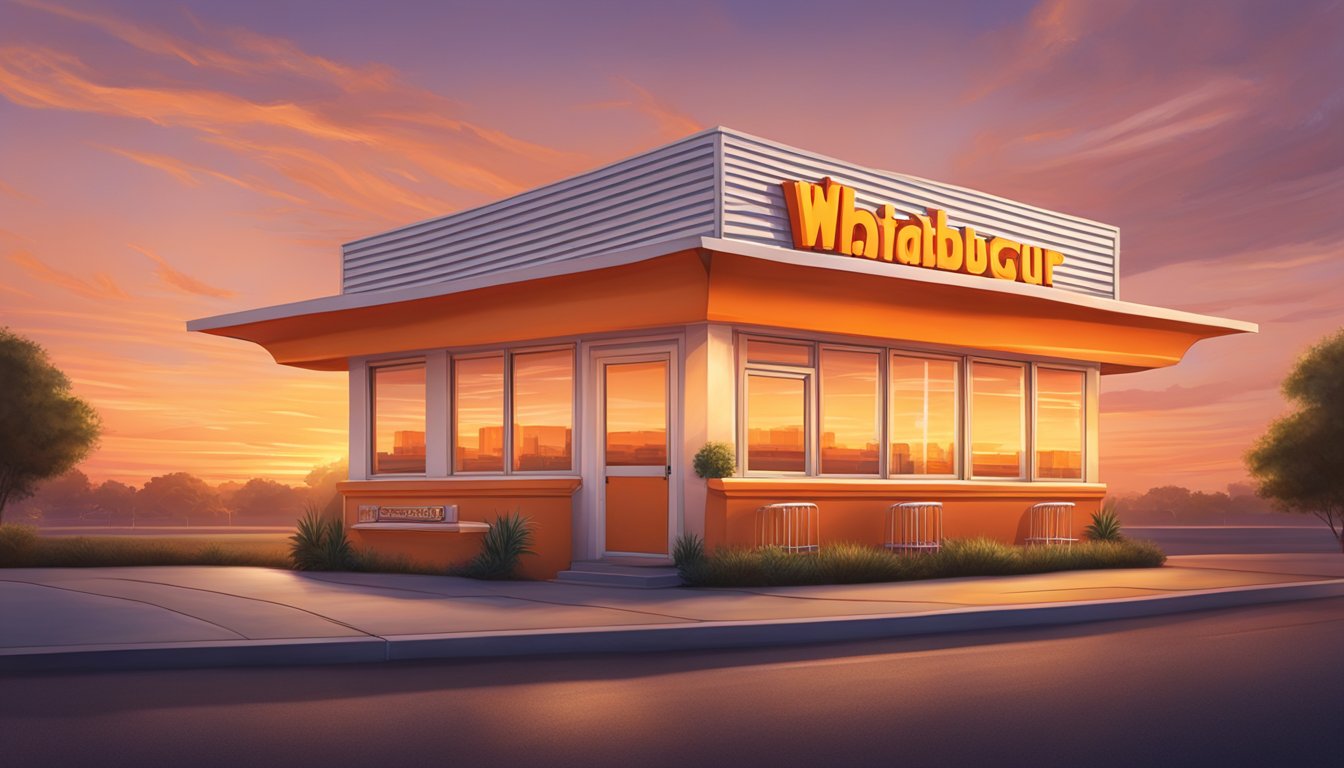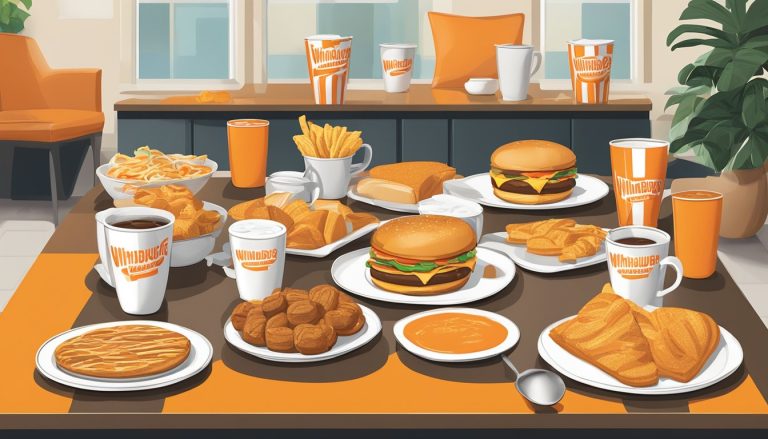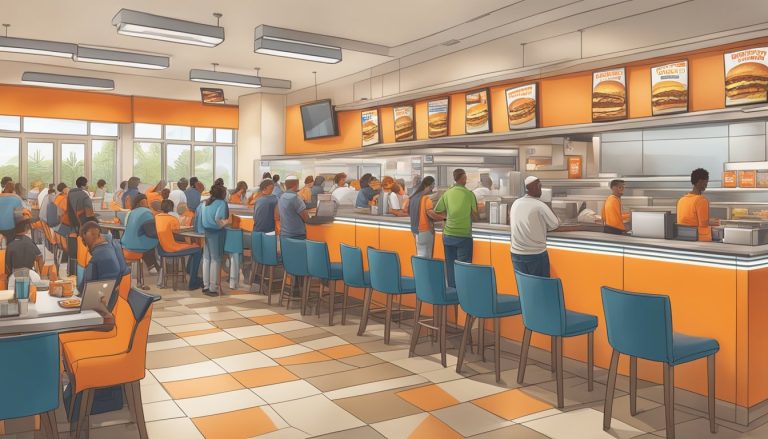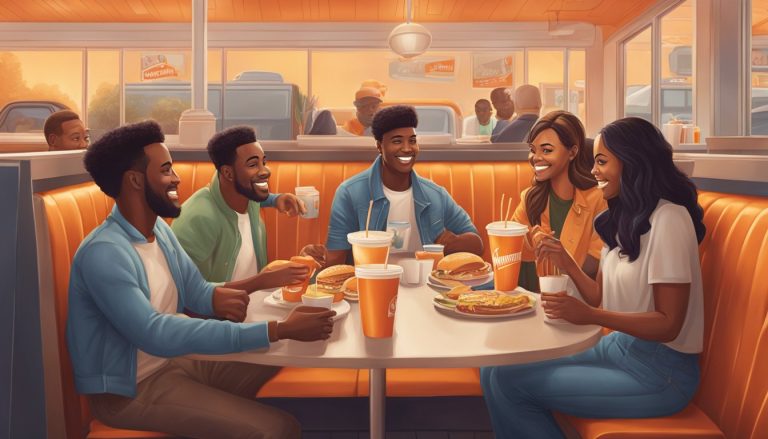Whataburger’s iconic orange and white color scheme is instantly recognizable to burger lovers across Texas and beyond. This distinctive visual identity has its roots in the fast-food chain’s early days and the founder’s aviation hobby.
Harmon Dobson, Whataburger’s creator, chose orange as the brand’s signature color to make his restaurants visible from the air. As a pilot, Dobson would fly over Corpus Christi, Texas, dropping coupons for free burgers to promote his new business. In 1961, he took this aerial marketing strategy a step further by constructing a large A-frame building painted in bright orange and white.
The bold orange hue served a dual purpose – catching the eye of potential customers on the ground and making Whataburger locations stand out from high altitudes. This clever marketing tactic helped establish Whataburger as a distinctive Texas brand, with its vibrant orange color becoming synonymous with the chain’s commitment to big, flavorful burgers that make people exclaim, “What a burger!”
The Origins of Whataburger

Whataburger’s journey began in 1950, rooted in one man’s vision to create an exceptional burger experience. The Texas-based chain quickly became a beloved institution, known for its quality and distinctive branding.
Harmon Dobson’s Vision
Harmon Dobson, an entrepreneur with a passion for aviation, founded Whataburger in 1950. His goal was simple yet ambitious: to create a burger so big and tasty that customers would exclaim, “What a burger!” This vision set the foundation for Whataburger’s commitment to quality and generous portions.
Dobson’s background in flying played a crucial role in shaping the brand’s identity. He used his piloting skills to advertise the business, flying a Whataburger banner over Corpus Christi and dropping free-burger coupons.
The First Whataburger Stand
The first Whataburger stand opened in Corpus Christi, Texas, on August 8, 1950. It was a humble beginning, with a simple menu featuring a quarter-pound burger on a 5-inch bun, drinks, and chips.
The stand’s success was immediate. On its first day, it sold $50 worth of burgers, fries, and drinks. Dobson’s emphasis on fresh ingredients and made-to-order burgers quickly set Whataburger apart from competitors.
Whataburger Becomes a Texas Treasure
Whataburger’s popularity grew rapidly across Texas. By 1960, there were 17 restaurants in operation. The chain’s expansion was marked by innovative marketing strategies and a commitment to maintaining quality.
In 1961, Dobson introduced the iconic A-frame design for Whataburger buildings. The orange and white color scheme, inspired by airport structures, made the restaurants easily recognizable from a distance.
The Texas State Historical Association recognizes Whataburger as a significant part of Texas culture. The chain’s loyal customer base and consistent quality have earned it the status of a true Texas treasure.
Decoding the Iconic Orange Color
Whataburger’s signature orange color has deep roots in aviation and engineering. This vibrant hue plays a crucial role in the brand’s identity and visibility.
Inspiration from Aviation and Beyond
Harmon Dobson, Whataburger’s founder, drew inspiration from his background as a pilot. In the 1950s, he used his aviation skills to promote the business, flying banners over Corpus Christi and dropping free burger coupons.
Dobson’s love for flying influenced the design of Whataburger stores. In 1961, he created a distinctive A-frame building painted white and orange. This unique architecture made the restaurants easily recognizable from the air.
The aviation connection extends beyond marketing tactics. The aerospace industry’s use of high-visibility colors likely influenced Dobson’s choice for Whataburger’s signature hue.
Choosing International Orange
Whataburger’s iconic shade closely resembles International Orange, a color with significant applications in aerospace and engineering. This vibrant hue is used on objects that need to stand out against various backgrounds.
The Golden Gate Bridge in San Francisco famously uses International Orange for its striking appearance and visibility in fog. Whataburger’s choice of a similar color ensures its restaurants are easily spotted from a distance.
This bold orange shade contrasts sharply with the white elements of Whataburger’s color scheme, creating a visually striking combination that catches the eye.
Brand Identity and Visibility
The orange and white color scheme has become synonymous with Whataburger’s brand identity. It features prominently in the company’s logo, store designs, and marketing materials.
The distinctive hue helps Whataburger stand out in crowded marketplaces and along busy streets. It creates a strong visual impact that aids in brand recognition and recall.
Whataburger’s commitment to this color scheme has remained consistent over the decades. This continuity has helped solidify the brand’s image in the minds of consumers, making the orange hue an integral part of Whataburger’s legacy.
The A-Frame Era and Restaurant Design

Whataburger’s iconic A-frame buildings became synonymous with the brand’s visual identity. These distinctive structures played a crucial role in the company’s expansion and recognition across multiple states.
Introduction of the A-Frame
The first Whataburger A-frame restaurant opened in 1961 in Odessa, Texas. This innovative design marked a significant shift in the company’s architectural approach. The A-frame structure stood 30 feet tall, featuring eye-catching orange and white stripes.
These buildings quickly became landmarks in their communities. The unique shape and vibrant colors made Whataburger restaurants easy to spot from a distance. This visual appeal contributed to increased customer traffic and brand recognition.
Evolution of Building Design
As Whataburger expanded, the A-frame design evolved to meet changing needs. The company experimented with variations of the original concept. Some locations incorporated elements of the A-frame while adapting to different lot sizes and local preferences.
In later years, Whataburger began transitioning away from the full A-frame structure. Modern designs retained the signature orange and white color scheme but featured more conventional building shapes. This shift allowed for greater flexibility in restaurant layout and improved operational efficiency.
Compliance with Building Codes
The A-frame design presented challenges as building codes evolved over time. Whataburger had to adapt its iconic structure to meet new safety and accessibility requirements. This often meant modifying entrances, adding ramps, or adjusting interior layouts.
In some cases, older A-frame buildings were renovated or replaced to comply with updated regulations. Despite these changes, Whataburger strived to maintain elements of its distinctive style. The company balanced preserving its architectural heritage with meeting modern building standards.
Menu Innovations and Whataburger Specialties

Whataburger has built its reputation on a diverse menu that combines classic favorites with innovative offerings. The chain’s commitment to quality ingredients and customization options has helped it maintain a loyal customer base.
Focus on Fresh, Customizable Burgers
Whataburger’s core menu revolves around its 100% pure beef patties. These burgers are made-to-order, allowing customers to customize their meals. Patrons can choose from various toppings, including lettuce, tomatoes, onions, and pickles. The restaurant also offers unique options like jalapeños and avocado.
Whataburger’s signature item is the Whataburger itself – a large beef patty served on a 5-inch bun. This burger can be customized with additional patties or toppings to suit individual preferences.
The chain takes pride in using fresh ingredients, ensuring that each burger is prepared when ordered rather than pre-made.
Signature Items and Fan Favorites
Beyond its classic burgers, Whataburger offers several unique menu items that have become fan favorites. The Whatachick’n Sandwich is a popular choice, featuring a crispy chicken fillet.
Whataburger’s sides are equally famous. Their French fries and onion rings are staple accompaniments to any meal. The chain’s “Fancy Ketchup” has developed a cult following, with many customers considering it a must-have condiment.
For those seeking a spicier kick, Whataburger introduced its Spicy Ketchup, which quickly became a hit among patrons.
Breakfast Menu and Beyond
Whataburger’s breakfast menu has expanded significantly over the years. The “Breakfast on a Bun” is a classic choice, featuring eggs, cheese, and a choice of bacon or sausage.
One standout item is the Honey Butter Chicken Biscuit, which combines a crispy chicken strip with honey butter sauce on a fluffy biscuit. This sweet and savory combination has become a beloved breakfast option.
Whataburger serves breakfast from 11 p.m. to 11 a.m., catering to both early risers and night owls. The extended breakfast hours have made Whataburger a popular choice for shift workers and late-night diners.
Expansion and Growth of the Whataburger Brand

Whataburger’s journey from a single burger stand to a major fast-food chain spans decades of strategic growth and expansion. The company’s development transformed it into a beloved icon across the Southern United States.
Whataburger’s Transition from a Burgers Joint to a Major Chain
Whataburger began its transition from a local burger joint to a major chain in the 1960s. The company launched its franchise program, allowing rapid expansion beyond its Corpus Christi roots.
By 1967, Whataburger had opened its 40th restaurant. This growth showcased the brand’s increasing popularity and business acumen.
The chain’s commitment to quality and customer service remained steadfast throughout its expansion. Whataburger’s signature large burgers continued to set it apart from competitors.
National Growth and Local Expansion
Whataburger’s growth beyond Texas began in the 1960s, marking the start of its national expansion efforts. The company strategically entered new markets while maintaining its Southern appeal.
By 2000, Whataburger celebrated its 50th anniversary with 575 restaurants. This milestone demonstrated the chain’s enduring popularity and successful expansion strategy.
The company continued its growth trajectory, surpassing 800 restaurants in subsequent years. This achievement solidified Whataburger’s position as a major player in the fast-food industry.
Ownership and Investment Partnerships
In 2019, Whataburger entered a new phase of ownership and investment. The Dobson family sold their majority stake to BDT Capital Partners, a merchant bank based in Chicago.
This partnership aimed to fuel further expansion while preserving Whataburger’s core values and Texas heritage. The Dobson family retained a minority stake in the business.
Under new ownership, Whataburger announced plans to expand into new markets. The company targeted states like Kansas and Missouri for growth opportunities.
Cultural Significance and Brand Loyalty

Whataburger’s orange and white colors have become deeply ingrained in Texas culture, fostering a strong sense of identity and loyalty among customers. The brand’s impact extends far beyond its food, creating a cultural phenomenon that resonates with Texans and visitors alike.
The Role of Whataburger in Texan Identity
Whataburger has become synonymous with Texas pride. The distinctive orange and white stripes serve as a beacon of home for many Texans. The brand’s presence at local events, sports games, and community gatherings reinforces its connection to Texan identity.
Whataburger’s influence is evident in popular culture, with references appearing in music, films, and social media. Texas-based artists and celebrities often showcase their Whataburger loyalty, further cementing the brand’s role in shaping Texan identity.
Beyond the Food: Whataburger as a Cultural Icon
Whataburger’s iconic status transcends its menu offerings. The brand has inspired a range of merchandise, from clothing to home decor. Notably, the collaboration with James Avery, a beloved Texas jeweler, resulted in a popular Whataburger charm.
The restaurant’s architecture, with its distinctive A-frame design and orange-and-white color scheme, has become a recognizable landmark across Texas and neighboring states. This visual presence contributes to Whataburger’s role as a cultural touchstone.
Fostering Customer Relationships and Loyalty
Whataburger’s success in building customer loyalty stems from its consistent quality and personalized service. The brand’s focus on customer satisfaction has created a dedicated following that spans generations.
Social media engagement plays a crucial role in maintaining customer relationships. Whataburger’s witty and relatable online presence has garnered a significant following, fostering a sense of community among fans.
The company’s commitment to local communities through charitable initiatives and sponsorships further strengthens its bond with customers. This approach has transformed Whataburger from a fast-food chain into a beloved institution that holds a special place in the hearts of many.
Marketing and Promotional Strategies

Whataburger’s marketing approach combines visual branding, customer engagement, and strategic partnerships. The iconic orange color plays a central role in the company’s identity and promotional efforts.
Iconic Logo’s Role in Marketing
The Whataburger logo PNG features the distinctive orange and white color scheme, instantly recognizable to fans. This visual branding extends to store designs, packaging, and advertising materials. The A-frame architecture of many Whataburger locations serves as a giant logo, visible from afar and reinforcing brand recognition.
The bold orange hue stands out in crowded fast-food landscapes, drawing attention to Whataburger stands. This consistent use of color across all touchpoints helps create a strong, cohesive brand image.
Promotions and Customer Engagement
Whataburger has employed creative promotional tactics since its early days. In the 1950s, founder Harmon Dobson dropped free-burger coupons from planes, creating buzz and attracting customers. Today, the chain uses a mix of traditional and digital marketing strategies.
Limited-time menu items and seasonal promotions keep customers excited and coming back. Social media campaigns encourage user-generated content and foster community engagement. Whataburger’s loyalty program rewards frequent visitors, incentivizing repeat business.
Merchandising and Brand Partnerships
Whataburger has expanded its brand reach through merchandise and partnerships. Fans can purchase clothing, accessories, and home goods featuring the iconic logo and orange color. These items turn customers into brand ambassadors.
The company collaborates with local sports teams and events, increasing visibility in its core markets. Partnerships with other brands for co-branded products create buzz and reach new audiences. Whataburger’s quarter-pound burger often features in these promotions, highlighting its signature menu item.




